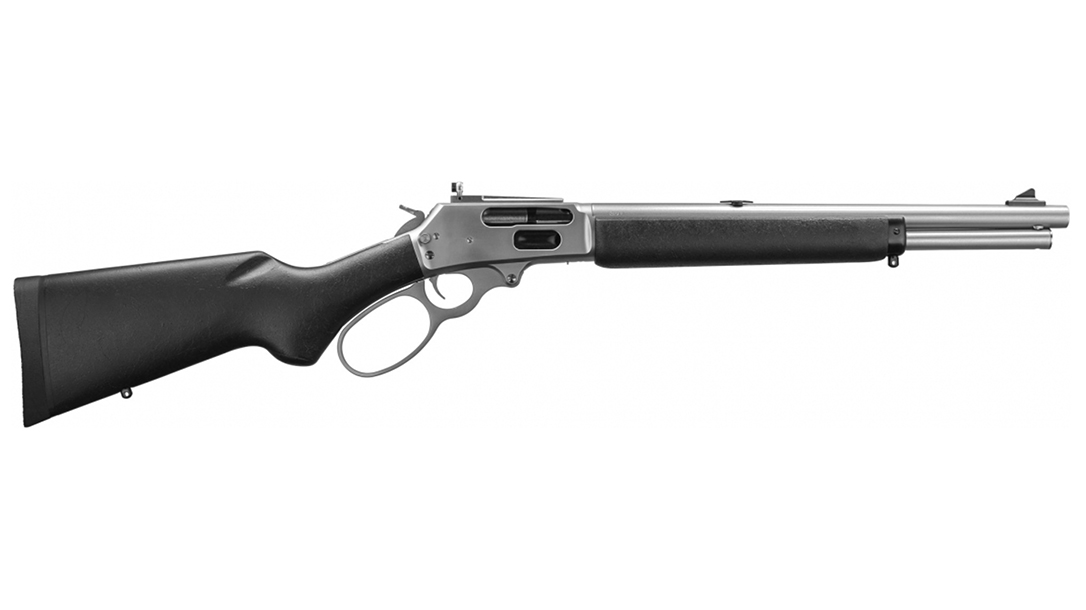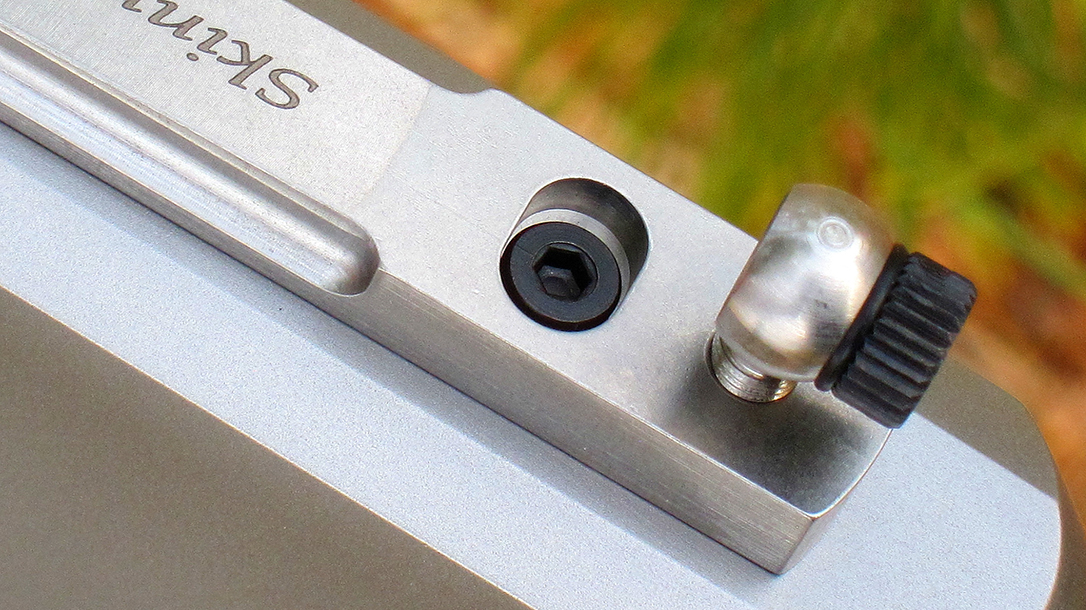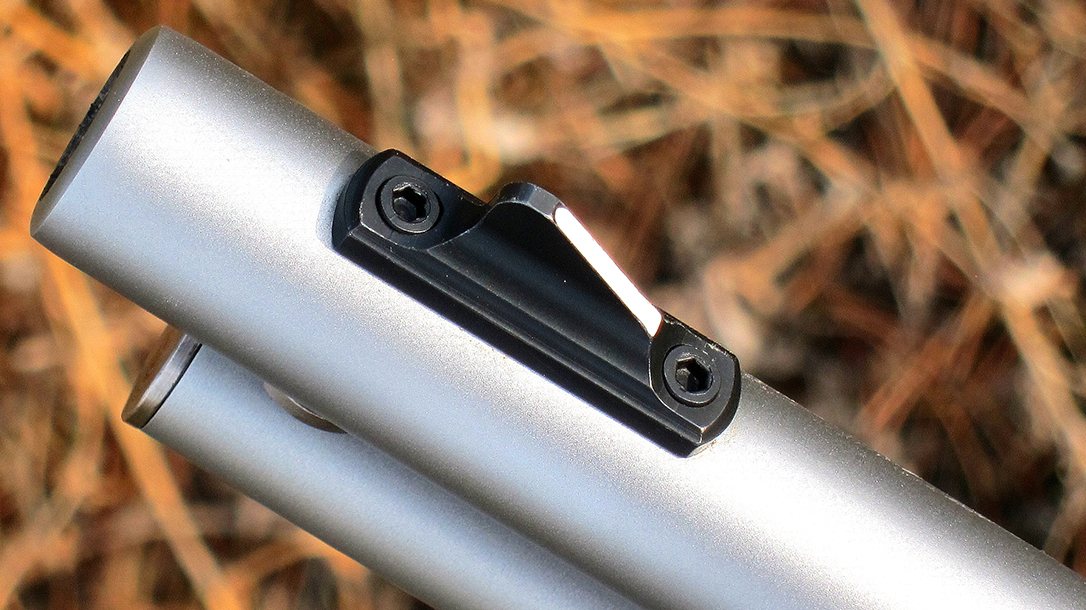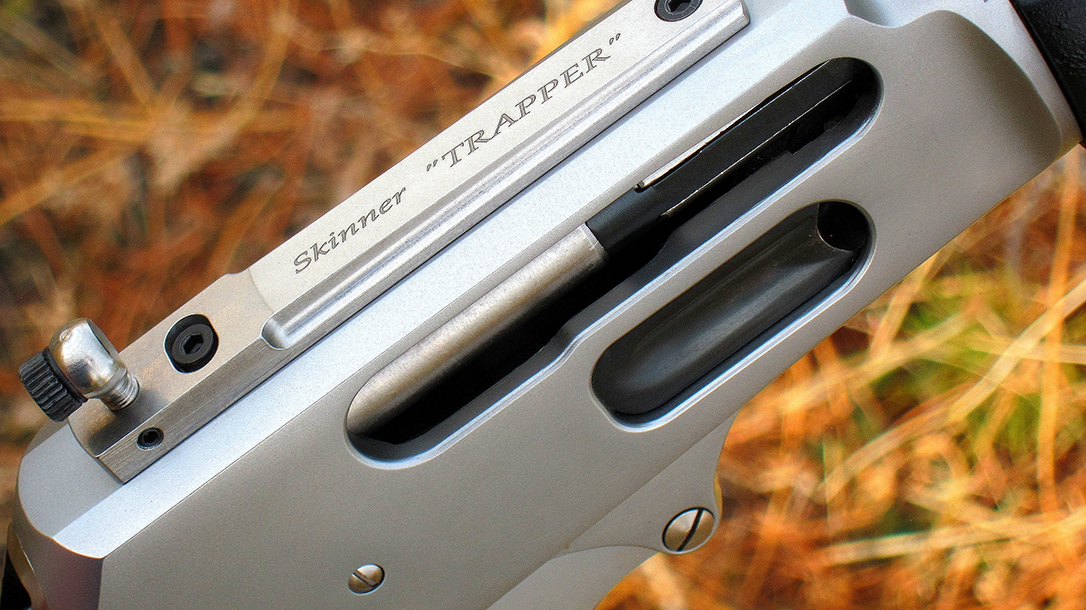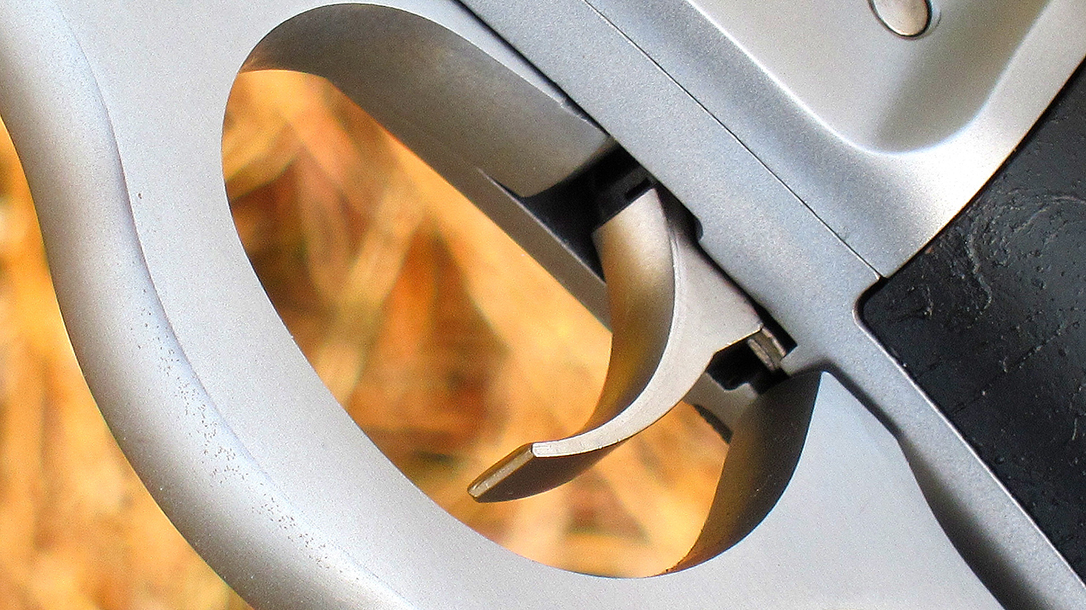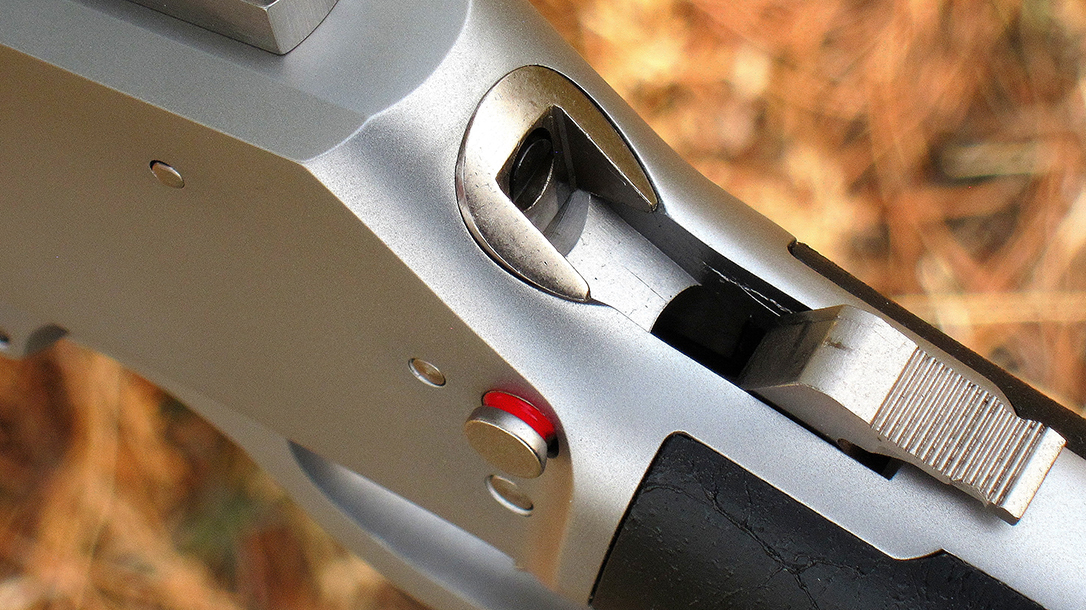There’s no point in prolonging it, or holding off till the end, I’ll just come right out and admit it now: I like this snub-nosed blaster. A levergun grabs me by the collar, a 16-inch barrel snatches my eye, a big-loop lever crowbars me back to my childhood, a .45-70 curls my toes. Put ‘em all together, and I’m a gonner.
And, put ‘em all together is exactly what Marlin’s done in late 2017. Built on the beefy 1895 frame, this one offers a trim-totin’ all-weather package of bead-blasted (not satin) stainless steel and water-resistant-coated birch furniture that’s intended for tight spaces, tough country, easy foot carry, and power on demand when a lesser squirrel gun just doesn’t get the job done.
Advertisement — Continue Reading Below
Firstly, I knew this one was in the works, and had to wait impatiently for several months for Marlin to get production rolling. Once they did, they kindly got a test sample packed on the big brown Christmas truck, and out of the box it immediately rivaled one of my favorite rifles, the old trusty Marlin Guide Gun that’s currently working through its second ATV and seen more trail dust than any other rifle I own.
Trapper Configuration
The two guns obviously share a common basic concept, but the Trapper’s 16.5-inch Ballard-rifled barrel shortens the newer gun by two inches below the Guide’s 18.5 barrel, and it extends the magazine capacity from the Guide’s four to the Trapper’s five. While this does involve a trade-off in velocity loss through such a short barrel, the gain of that one additional round all loaded up and ready to go can make a difference in both your peace of mind and a piece of whatever large & furry [please leave intact as written] might be facing off for a charge in the wilds. This is where I personally think the “ancient” .45-70 caliber shines, incidentally, and it’s why I chose it over anything else in a quick-handling levergun for the back country.
The Trapper’s pistolgrip wrist is another variation on the theme, and I will say here that I’m ambivalent on this. The pistolgrip’s arc gives the shooting hand a more natural angle in use, but it also requires a longer wrist throw on the lever to cycle the bolt. The lever starts out at a lower angle from the bore-line at rest, and it has to travel farther forward away from the body to move the bolt the same distance rearward.
Advertisement — Continue Reading Below
This is further magnified by the big lever loop, and the net result is that you end up with a notably longer arm extension in use. A notably longer arm itself comes in handy to compensate, and the pistolgrip profile may make a difference to traditionalists who feel that if there’s one thing John Wayne taught us, it’s that the quintessential levergun should have a straight wrist. But, otherwise it’s largely a matter of personal preference, and it didn’t take long to get used to the lever throw at the range.
Big Loop Style
I know- it’s Hollywoodish, which is exactly why it appeals to ingrained Chuck Connors memories and the Hubley Rifleman capgun that saw me through so many adventures when I was seven years old. The big loop lever actually slows cycling down in real life, which the Cowboy Action Shooting sport proved quite a while back, but….it’s just so cowboy cool that it instantly adds style points galore to any lever-action it’s installed on, and if anybody calls you on it, you just say “It’s for the gloves. Honest.” This can work anywhere from the Klondike to the Everglades, just wave the appropriate type of glove as needed to make it convincing.
There are target sights, hunting sights, and quick-reaction sights that sorta split the difference. In a gun like this, you want a clear sight picture that picks up in a hurry, but those sights need to be big, precise, and adjustable to match up with your preferred load. Considering the very wide range of possibilities in the caliber in factory ammunition alone, not to mention the wide-open world of handloading, you can count on this Marlin to toss out mild lead 405s at 1300 feet per second through heavy lead 540s at 1400 FPS to jacketed 300s at 2200 FPS (or thereabouts, considering the barrel length); and that much variation in potential bullet trajectories absolutely demands a sighting system that can give you enough elevation adjustment to compensate.
Advertisement — Continue Reading Below
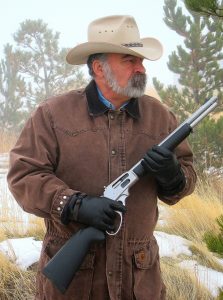 Skinner Sights
Skinner Sights
Marlin chose Skinners for the Trapper, using appropriately the stainless steel “Trapper” rear base and post, with a blued .125” insert that can be removed for use leaving the resulting aperture at .200” as a ghost ring option, paired with Skinner’s two-screw white-line Bear Buster ramped front blade. Skinner sights are a popular choice on working rifles, and the sturdy combo on this short Trapper carbine comes with plenty of adjustment for both windage and elevation. But- those adjustments are not click-adjustable, and they do require a small hex wrench to make.
To adjust for elevation, loosen the locking screw in the right side of the base, screw the aperture post up or down as needed to raise or lower bullet point of impact, then tighten up the locking screw again. Windage is done by loosening the rear sight base main screw on top, carefully swiveling the back end of the base left or right slightly to whatever position centers your bullet impact, and then snugging that back screw down tight. A hint here: you can also loosen the front base screw while you’re adjusting for windage, but if you leave it tight it’s easier to just make small back-end movements without overdoing and wandering farther than you intended. Once you move that back end, there are no markings to use as reference points to return to where you started.
Zeroing the Marlin Model 1895 Trapper
Plan on zeroing your gun at the range with your best load, and don’t expect to be making quick changes in the field without a wrench along. This isn’t a criticism, just an advisory. I’ve used Skinners elsewhere and talked to Andy Skinner personally; he takes his operation seriously and puts out a quality product line. He also offers five different aperture sizes on his www.skinnersights.com site, so you can personalize there, and the front Bearbuster blade is machined from solid barstock at .500”, with options at .570” in all-blue steel, white-line, and brass. Additionally, he can match his sights to any .45-70 load you’ve got, if it falls outside the range of what comes on the Marlin.
Advertisement — Continue Reading Below
Marlin Evolution
Something else we should get into before we go much further- the Post-Move Marlin Quality Issue. No denying it, fair to say that the leverguns Marlin turned out during the period immediately after the move from the aging plant in Connecticut to the new plant in New York had several quality problems. During the process of integrating new equipment and new employees, it’s been a steep learning curve. But, the good news is that the company has been making steady improvement in bringing back older models that were temporarily suspended, bringing out new models, and bringing up overall quality levels.
My oldest Marlin dates to roughly 1905-1915, and I’ve owned and worked with several over the years. I saw the decline before and after the move, and for several years afterward I’d look, but never saw one I thought was back close enough to snuff to work with again. I’ve seen enough improvement in recent samples to risk it, though, and the result is this write-up. I can hear the question you’re asking already- is the gun up to where it should be? And the answer is….pretty much almost.
Marlin Model 1895 Trapper Hits & Misses
On the plus side, machining is tight, straight, well-fitted on steel-to-steel joins, and stock & fore-end [please leave as written] are well-mated to the receiver at both ends. Unlike early post-move samples, this Trapper has no sixteenth-inch gaps between wood and steel, filled with what appeared to be bubblegum; and there are no canted sights, mis-aligned magazine tubes, and off-kilter machined dovetails. The action was already smooth before the range session, and the trigger pull was a surprisingly clean and repeatable 5-pounds with no creep and no overtravel.
Advertisement — Continue Reading Below
The coated birch hardwood (which isn’t a negative, there’s just no reason to waste good walnut where the grain won’t be seen) has no checkering, but the finish is textured just enough for a non-slip hold in even wet conditions, and the black solid rubber Pachmayr Decelerator recoil pad has enough give to function well under heavy recoil. The gun fed and fired everything I put through it at the range without any hiccups, and the sights we’ve already gone over.
On the non-plus side? Numerous edges that need….no, let’s be honest and say demand to be rounded off. The trigger drew blood on the first shot under recoil, and I do know how to shoot a thumper. There is absolutely no good reason whatever for this trigger to be that sharp, and along with the ice-scraper edges on the inside of the lever, combined with the sharp corners on the hammer and the sharp points on the rear sight dovetail plug, this is an otherwise great concept and configuration, but one you have watch in handling and shooting.
Marlin Model 1895 Trapper On the Range
I ended up doing most of the range work by shooting with my hand curled around outside the lever, and very carefully watching where I placed my trigger finger on every shot. Moreover, this is not the way a bear-shield should have to be approached. In a hurry, very easy to spear that trigger through a finger on successive shots while closing the action under stress; uncomfortable to say the least in working the lever with bare hands.
Advertisement — Continue Reading Below
This has been discussed with Marlin, who acknowledged the problem, told me they’ll be working on the sharps, and (to their credit) had no heartburn over me writing the Trapper up as I found it. I’d expect to see some improvement on at least the trigger and the lever edges. In the meantime, a good gunsmith could quickly address the lever and replace the sharp sight plug with a smooth rounded-edge one like I have on my Guide, but there may be some minor nuisance involving an after-buy trigger fix.
Most of the Trapper’s major components feature stainless steel. However, the trigger is one of a few smaller parts utilizing nickel plating. When you grind or file down through plating in rounding corners and edges, you can begin a degradation process with the rest of the plating on that part. There are, fortunately, aftermarket triggers available if you need to look for them. The hammer is through and through stainless, so that’s easy to clean up yourself at home with a fine diamond file. Further, between hammer, trigger, and lever, those are your major interface with this levergun, and that interface should not cost you skin cells.
Advertisement — Continue Reading Below
Boom!
A 47-degree sunny day under calm wind conditions, off a concrete bench at 100 yards, with three jacketed 300-grainers and one jacketed 405-grainer, brought out another reminder that my eyes don’t do well with aperture sights nowdays. The Skinner sights are fine, the fault was just my well-worn eyes.
The Marlin and I were still able to put three holes in under two inches now and then with a couple of the loads, and all four could hold three-shot groups under four inches. That’s tight enough for hunting at practical .45-70 lever-action distances, and perfectly fine for close encounters of the brushy kind. Recoil-wise, the Trapper lets you know when a high-performance premium load ignites, and there’s a shade more muzzle rise than a longer barrel usually generates, but it was all tolerable and all just part of the .45-70 game you sign up for when you adopt the caliber.
Speaking of shade, even under the full overhead canopy of the state range I shot the Trapper at, I saw no signs of the short-barrel muzzle flash I was expecting from unburned powder through that 16.5-inch tube. Additionally, the rubber pad did its job well, the action gave me no bobbles, and most empty brass dropped neatly on the table next to the gun with normal lever effort. My back told me all the way home how grateful it was for that at the end of the day, without having to do the usual brass-pickup bend-overs. I could have tossed the empties further by running the lever harder, but the point is that it wasn’t necessary for reliable cycling, and that’s OK with me.
Advertisement — Continue Reading Below
Final Thoughts
This new Trapper could find a place in my truck without much effort at all. Also, with just a little tweaking, it’d be one of the most interesting Marlins in their line-up for my tastes, and I’m glad to see the company coming back into serious running with the leverguns they built their reputation on. If you’ve held off checking them out because of all the sad tales of problematical quality, give ‘em another chance. Above all, it’s time.
For more information, visit marlinfirearms.com.
Marlin Model 1895 Trapper Specifications
- Caliber: .45-70
- Overall Barrel Length: 16½ inches
- Overall Length: 34¾ inches
- Stock: Black birch
- Overall Weight: 7 pounds (empty)
- Sights: Blade front, Skinner peep rear
- Action: Lever
- Finish: Stainless
- Capacity: 5+1
- MSRP: $1,123
This article is from the Winter 2019 issue of Guns of the Old West magazine. Grab your copy at OutdoorGroupStore.com
